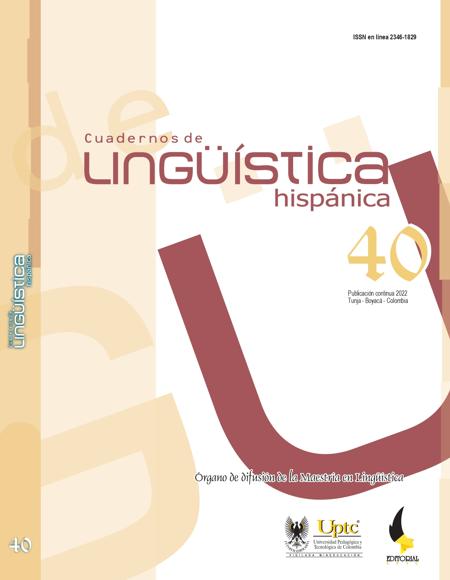Modeling of Plural Concordance Errors in Spanish as Foreign Language Using Dynamic Systems

Abstract
The purpose of this paper is to model plural nominal concordance errors for a Spanish corpus of four learners of Spanish as a foreign language: SONIA (level A1/A2), NATI (level B1), JAKO (level B2), MIRKA (level C1). In the framework of dynamical systems, it is postulated that “correct” and “incorrect” concordances constitute stable discrete attractors to which the continuous flow of the system converges in three simple simulation models: Lokta-Volterra, coordination game (evolutionary games theory), gradient ascent. As a result, the models better approximate the global error pattern than the session pattern. In the latter, the model based on Lokta-Volterra offers better performance for SONIA, NATI and JAKO. MIRKA obtains the worst performance in all the models, but its error decreases with the gradient ascent model. It is concluded that learning patterns are self-organized and emerge from the dynamics of concordance microsystems.
Keywords
modelo de simulación, adquisición de L2, sistemas dinámicos, número plural
Author Biography
Pablo Ezequiel Marafioti
Doctor en Ciencias del Lenguaje por la Universidad Nacional de Córdoba, Argentina; especialista en Lingüística Teórica y Aplicada por la Universidad de Pavía, Italia; licenciado en Letras (orientación en Lingüística) por la Universidad de Buenos Aires, Argentina. Realizó varios posgrados en Estadística. Áreas de especialización: sistemas dinámicos, modelos estadísticos y de minería de datos aplicados al cambio lingüístico y a la adquisiciónde lenguas extranjeras
References
- Brehm, L, Cho, P. W., Smolensky, P. y Goldrick, M. (2022). PIPS: a parallel planning model of sentence production. Cognitive Science, 46. https://doi.org/10.1111/cogs.13079
- Cho, P. W., Goldrick, M., y Smolensky, P. (2017). Incremental parsing in a continuous dynamical system: Sentence procesing in Gradient Symbolic Computation. Linguistics Vanguard, 3(1). https://doi.org/1.1515/lingvan-2016-0105
- Cho, P. W., Goldrick, M., Lewis, R., y Smolensky, P. (2018). Dynamic encoding of structural uncertainty in gradient symbols. En A. Sayeed, C. Jacobs, T. Linzen y M. van Schijndel (Eds.), Proceedings of the 8th Workshop on Cognitive Modeling and Computational Linguistics (pp. 19-28). Salt Lake City, Utah, USA. https://doi.org/1.18653/v1/W18-01
- Cho, P. W., Goldrick, M., y Smolensky, P. (2020). Parallel parsing in a Gradient Symbolic Computation parser [en línea]. https://doi.org/1.31234/osf.io/utcgv
- Davis, C., y Perea, M. (2005). BuscaPalabras: a program for deriving orthographic and phonological neighborhood statistics and other psycholinguistic indices in Spanish. Behavior Research Methods, 37(4), 665-671. https://doi.org/1.3758/BF03192738.
- Deo, A. (2015). The semantic and pragmatic underpinnings of grammaticalization paths: The progressive to imperfective shift. Semantics and Pragmatics, 8, 1-52. http://dx.doi.org/1.3765/sp.8.14
- Kaplan, D., y Glass, L. (1995). Understanding Nonlinear Dynamics. New York: Springer.
- Kilgarriff, A., Baisa, V., Bušta, J., Jakubíček, M., Kovář, V., Michelfeit, J., Rychlý, P., y Suchomel, V. (2014). The Sketch Engine: Ten years on. Lexicography, 1(1), 7-36. https://doi.org/1.1007/s40607-014-0009-9.
- Kot, Mark (2001). Elements of mathematical ecology. Cambridge University Press.
- Nerbonne, J., Van Ommen, S., Gooskens, C., y Wieling, M. (2013). Measuring socially motivated pronunciation differences. En L. Borin y A. Saxena (Eds.), Approaches to Measuring Linguistic Differences (pp. 107–140). https://doi.org/1.1515/9783110305258.
- MacWhinney, B. (2015). Introduction. En B. MacWhinney y W. O’Grady (Eds.), The Handbook of Language Emergence (pp. 1-31). Sussex: Wiley y Sons.
- Mac Whinney, B. (2021). The Childes Project: Tools for Analyzing Talk. Part 1 y 2 [en línea]. Disponible en: https://talkbank.org/manuals/CHAT.pdf.
- Marafioti, P. E. (2021). Factores influyentes en tipos de errores de concordancia nominal en un corpus de cuatro aprendientes italianos de español LE. Lenguaje, 49(2), 365-393. https://doi.org/10.25100/lenguaje.v49i2.10915.
- Marafioti, P. E. (2022). Análisis de tiempos hasta que se produce un error de concordancia en cuatro estudiantes italianos de ELE. Revista argentina de ciencias del comportamiento, 13(2). [en prensa]
- Murray, James D. (2002). Mathematical Biology I. An Introduction (3ra. ed.). New York: Springer.
- Peña, D. (2002). Análisis de Datos Multivariantes. Mc Graw Hill.
- R Development Core Team. (2021). R: a language and environment for statistical computing. R Foundation for Statistical Computing, Vienna, Austria. http://www.R-project.org.
- Smith, G., y Tavor, W. (2018). Toward a Theory of Timing Effects in Self-Organized Sentence Processing. En I. Juvina, J. Houpt y C. Myers (Eds.), Proceedings of the 16th international conference on cognitive modeling (pp. 138-143). Madison, Wisconsin: University of Wisconsin. http://acs.ist.psu.edu/papers/ICCM%202018%20Proceedings.pdf
- Smith, G., Franck, J., y Tabor, W. (2018). A self-organizing approach to subject-verb number agreement. Cognitive Science, 42(S4), 1043–1074. https://doi.org/1.1111/cogs.12591.
- Smith, G., Franck, J., y Tabor, W. (2021). Encoding interference effects support self-organized sentence processing. Cognitive Psychology, 124(101356). https://doi.org/1.1016/j.cogpsych.202.101356
- Smolensky, P, Goldrick, M., y Mathis, D. (2014). Optimization and quantization in gradient symbol systems: a framework for integrating the continuous and the discrete in cognition. Cognitive Science, 38(6), 1102-1138. https://doi.org/1.1111/cogs.12047
- Scrucca, L., Fop, M., Murphy, T, y Raftery, A. (2016). Mclust 5: Clustering, classification and density estimation using Gaussian finite mixture models. The R Journal, 8(1), 289-317. https://doi.org/1.32614/RJ-2016-021.
- Van Buuren, S., y Groothuis-Oudshoorn, K. (2011). Mice: multivariate imputation by chained equations in R. Journal of Statistical Software, 45(3), 1-67. https//doi.org/10.18637/jss.v045.i03
- Weibull, J. W. (1997). Evolutionary game theory. Massachusetts: MIT Press.
